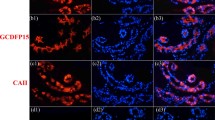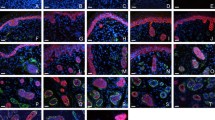Abstract
The presence and cellular distribution of subunits of the V1 sector of the vacuolar-type H+-ATPase (V-ATPase) was investigated in isolated human eccrine sweat glands. In every instance, V-ATPase was located in the cytoplasm and apical membranes of the luminal cells of the reabsorptive duct segment. In the secretory coil, both diffuse and perinuclear staining was demonstrated in the secretory cells, with additional expression at the apical and basolateral membranes and on the intercellular canaliculi. There was no detectable difference in V-ATPase expression as a result of prior application of 100 µM acetylcholine.
Similar content being viewed by others
References cited
Bastani B, Purcell H, Hemken P, Trigg D, Gluck S (1991) Expression and distribution of vacuolar proton-translocating adenosine triphosphate in response to chronic acid and alkali loads in the rat. J Clin Invest 88: 126-136.
Bovell DL, Elder HY, Jenkinson DM, Wilson SM (1990) The effect of removal of extracellular Cl- on the K+ (86Rb+) efflux from the isolated human sweat gland. J Physiol 420: 144P.
Briggman JV, Tashian RE, Spicer SS (1983) Immunocytochemical localisation of carbonic anhydrase I and II in eccrine sweat glands from control subjects and patients with cystic fibrosis. Amer J Path 112: 250-257.
Brown D (1989) Membrane recycling and epithelial cell function. Am J Physiol 256: F1-F12.
Brown D, Breton S (1996) Mitochondria-rich, proton-secreting epithelial cells. J Exp Biol 199: 2345-2358.
Brown D, Hirsch S, Gluck S (1988a) An H+-ATPase in opposite plasma membrane domains in kidney epithelial cell subpopulations. Nature 331: 622-624.
Brown D, Hirsch S, Gluck S (1988b) Localisation of a proton pumping ATPase in rat kidney. J Clin Invest 82: 2114-2126.
Burry JS, Marsolais M, Laprade R, Beck JS (1997) Apical and basolateral water permeabilities of the reabsorptive duct of the human eccrine sweat gland studied in vitro. Wein Klin Wochen 109: 542.
Dobson RL, Formisano V, Lobitz WC, Brophy D (1958) Some histochemical observations on the human eccrine sweat glands. J Invest Dermatol 31: 147-159.
Emrich HM, Olert H (1966) pH-wert und gesamtammoniak im menschlichen Schwiss. Pflügers Arch 290: 311-314.
FinbowME, Harrison MA (1997). The vacuolarHC-ATPase:Auniversal proton pump of eukaryotes. Biochem J 324: 697-712.
Frizzell RA, Field M, Schultz SG (1979) Sodium-coupled transport by epithelial tissues. Am J Physiol 236: F1-F8.
Hibbs RG (1958) The fine structure of human sweat glands. Am J Anat 103: 201-217.
Jones CJ, Kealey T (1987) Electrophysiological and dye-coupling studies on secretory, myoepithelial and duct cells in human eccrine sweat glands, with an appendix on eccrine sweat glands isolated from patients with cystic fibrosis. J Physiol 389: 461-481.
Lee CM, Jones CJ, Kealey T (1984) Biochemical and ultrastructural studies of human eccrine sweat glands isolated by shearing and maintained for seven days. J Cell Sci 72: 259-274.
Montgomery I, Jenkinson DM, Elder HY, Czarnecki D, MacKie RM (1984). The effects of stimulation on the ultrastructure of the human atrichial sweat gland. 1 The fundus. Br J Derm 110: 385-397.
Munger BL, Brusilow SW, Cooke RE (1961) An electron microscopic study of eccrine sweat glands in patients with cystic fibrosis of the sweat gland. J Pediatr 59: 497-511.
Quinton PM (1979). Water Metabolism: Protozoa to Man. Basel: Krager.
Quinton PM (1983). Chloride impermeability in cystic fibrosis. Nature 301: 421-422.
Quinton PM (1999). Physiological basis of cystic fibrosis: A historical perspective. Physiol Rev 79: S3-S22.
Quinton PM, Tormey JM (1976) Localisation of Na/KATPase sites in the secretory and reabsorptive epithelia of perfused eccrine sweat glands: A question to the role of the enzyme in secretion. J Membr Biol 29: 383-399.
Quinton PM, Reddy MM (1989) Cl- conductance and acid secretion in the human sweat duct. Ann NY Acad Sci 574: 438-446.
Quinton PM, Elder HY, Jenkinson DMcE, Bovell DL (1999) The structure and function of human sweat glands. In: Karl Laden, ed. Antiperspirants and Deodorants, 2nd edn. New York: Marcel Dekker, pp. 17-57.
Reddy MM, Quinton PM (1993) HCO3 - impermeability via CFTR Cl conductance in sweat duct. Pediatr Pulmonol 9: R21.
Reddy MM, Quinton PM (1994a) Rapid regulation of electrolyte absorption in sweat duct. J Membr Biol 140: 57-67.
Reddy MM, Quinton PM (1994b) Intracellular Cl activity-evidence of dual mechanisms of Cl absorption in sweat duct. Am J Physiol 36(4): C1136-C1144.
Reddy MM, Quinton PM (1996) Hydrolytic and non-hydrolytic interactions in the ATP regulation of CFTR Cl- conductance. Am J Physiol 270: C35-C42.
Reddy MM, Light MJ, Quinton PM (1999) Activation of the epithelial NaC channel (ENaC) requires CFTR Cl-channel function. Nature 402: 301-304.
Roussa E, Thevenod F (1998) Distribution of V-ATPase in rat salivary gland. Eur J Morphol 36(Suppl.): 147-152.
Sato K (1973) Sweat induction from an isolated eccrine sweat gland. Am J Physiol 225(5): 1147-1152.
Sato K, Kang WH, Saga K, Sato KT (1989) Biology of the sweat glands and their disorders. I. Normal sweat gland function. J Am Acad Dermatol 20: 537-563.
Schultz I (1969) Micropuncture studies of the sweat formation in cystic fibrosis patients. J Clin Invest 48: 1470-1477.
Silva P, Stoff J, Field M, Fine L, Forrest JN, Epstein JH (1977) Mechanism of active chloride secretion by shark rectal gland: Role of Na-K-ATPase in chloride transport. Am J Physiol 232: F298-F306.
Thaysen JH (1978) The Sweat Glands. Heidelberg, New York: Springer-Verlag.
Wieczorek H, Brown D, Grinstein S, Eherenfeld J, Harvey WR (1999) Animal plasma membrane energization by proton-motive V-ATPases. BioEssays 21: 637-648.
Wilson SM, Bovell DL, Elder HY, Jenkinson DM, Pediani JD (1990) The effects of removing external sodium upon the control of potassium (86Rb+) permeability in the isolated human sweat gland. Exp Physiol 75: 649-656.
Author information
Authors and Affiliations
Rights and permissions
About this article
Cite this article
Bovell, D., Clunes, M., Roussa, E. et al. Vacuolar-type H+-ATPase Distribution in Unstimulated and Acetylcholine-activated Isolated Human Eccrine Sweat Glands. Histochem J 32, 409–413 (2000). https://doi.org/10.1023/A:1004087120735
Issue Date:
DOI: https://doi.org/10.1023/A:1004087120735




